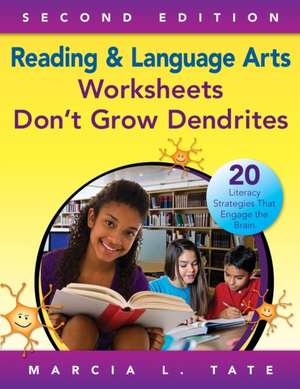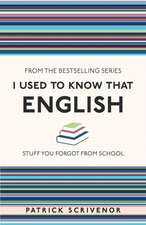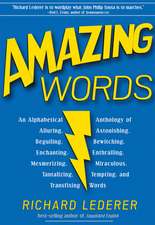Reading and Language Arts Worksheets Don't Grow Dendrites: 20 Literacy Strategies That Engage the Brain
Autor Marcia L. Tateen Limba Engleză Paperback – 20 ian 2014
- Phonemic awareness
- Phonics and vocabulary instruction
- Text comprehension
- Reading authentically, widely, and strategically
- Writing strategically
- Creating, critiquing, and discussing texts
- Conducting research
- Using technological resources
- Respecting diversity in language
- Participating in literary communities
- Using language to accomplish purposes
Preț: 274.63 lei
Nou
Puncte Express: 412
Preț estimativ în valută:
52.55€ • 57.26$ • 44.28£
52.55€ • 57.26$ • 44.28£
Carte disponibilă
Livrare economică 02-16 aprilie
Preluare comenzi: 021 569.72.76
Specificații
ISBN-13: 9781452280301
ISBN-10: 1452280304
Pagini: 200
Ilustrații: Illustrations
Dimensiuni: 216 x 279 x 12 mm
Greutate: 0.57 kg
Ediția:Second Edition
Editura: SAGE Publications
Colecția Corwin
Locul publicării:Thousand Oaks, United States
ISBN-10: 1452280304
Pagini: 200
Ilustrații: Illustrations
Dimensiuni: 216 x 279 x 12 mm
Greutate: 0.57 kg
Ediția:Second Edition
Editura: SAGE Publications
Colecția Corwin
Locul publicării:Thousand Oaks, United States
Cuprins
Acknowledgments
About the Author
Introduction
Strategy 1: Brainstorming and Discussion
What: Defining the Strategy
Why: Theoretical Framework
How: Instructional Activities
Reflection and Application
Strategy 2: Drawing and Artwork
What: Defining the Strategy
Why: Theoretical Framework
How: Instructional Activities
Reflection and Application
Strategy 3: Field Trips
What: Defining the Strategy
Why: Theoretical Framework
How: Instructional Activities
Reflection and Application
Strategy 4: Games
What: Defining the Strategy
Why: Theoretical Framework
How: Instructional Activities
Reflection and Application
Strategy 5: Graphic Organizers, Semantic Maps, and Word Webs
What: Defining the Strategy
Why: Theoretical Framework
How: Instructional Activities
Reflection and Application
Strategy 6: Humor
What: Defining the Strategy
Why: Theoretical Framework
How: Instructional Activities
Reflection and Application
Strategy 7: Manipulatives, Experiments, Labs, and Models
What: Defining the Strategy
Why: Theoretical Framework
How: Instructional Activities
Reflection and Application
Strategy 8: Metaphors, Analogies, and Similes
What: Defining the Strategy
Why: Theoretical Framework
How: Instructional Activities
Reflection and Application
Strategy 9: Mnemonic Devices
What: Defining the Strategy
Why: Theoretical Framework
How: Instructional Activities
Reflection and Application
Strategy 10: Movement
What: Defining the Strategy
Why: Theoretical Framework
How: Instructional Activities
Reflection and Application
Strategy 11: Music, Rhythm, Rhyme, and Rap
What: Defining the Strategy
Why: Theoretical Framework
How: Instructional Activities
Reflection and Application
Strategy 12: Project-Based and Problem-Based Instruction
What: Defining the Strategy
Why: Theoretical Framework
How: Instructional Activities
Reflection and Application
Strategy 13: Reciprocal Teaching and Cooperative Learning
What: Defining the Strategy
Why: Theoretical Framework
How: Instructional Activities
Reflection and Application
Strategy 14: Role Plays, Drama, Pantomimes, and Charades
What: Defining the Strategy
Why: Theoretical Framework
How: Instructional Activities
Reflection and Application
Strategy 15: Storytelling
What: Defining the Strategy
Why: Theoretical Framework
How: Instructional Activities
Reflection and Application
Strategy 16: Technology
What: Defining the Strategy
Why: Theoretical Framework
How: Instructional Activities
Reflection and Application
Strategy 17: Visualization and Guided Imagery
What: Defining the Strategy
Why: Theoretical Framework
How: Instructional Activities
Reflection and Application
Strategy 18: Visuals
What: Defining the Strategy
Why: Theoretical Framework
How: Instructional Activities
Reflection and Application
Strategy 19: Work Study and Apprenticeships
What: Defining the Strategy
Why: Theoretical Framework
How: Instructional Activities
Reflection and Application
Strategy 20: Writing and Journals
What: Defining the Strategy
Why: Theoretical Framework
How: Instructional Activities
Reflection and Application
Resource A: Brain-Compatible Lesson Design
Resource B: Graphic Organizers
Bibliography
Index
About the Author
Introduction
Strategy 1: Brainstorming and Discussion
What: Defining the Strategy
Why: Theoretical Framework
How: Instructional Activities
Reflection and Application
Strategy 2: Drawing and Artwork
What: Defining the Strategy
Why: Theoretical Framework
How: Instructional Activities
Reflection and Application
Strategy 3: Field Trips
What: Defining the Strategy
Why: Theoretical Framework
How: Instructional Activities
Reflection and Application
Strategy 4: Games
What: Defining the Strategy
Why: Theoretical Framework
How: Instructional Activities
Reflection and Application
Strategy 5: Graphic Organizers, Semantic Maps, and Word Webs
What: Defining the Strategy
Why: Theoretical Framework
How: Instructional Activities
Reflection and Application
Strategy 6: Humor
What: Defining the Strategy
Why: Theoretical Framework
How: Instructional Activities
Reflection and Application
Strategy 7: Manipulatives, Experiments, Labs, and Models
What: Defining the Strategy
Why: Theoretical Framework
How: Instructional Activities
Reflection and Application
Strategy 8: Metaphors, Analogies, and Similes
What: Defining the Strategy
Why: Theoretical Framework
How: Instructional Activities
Reflection and Application
Strategy 9: Mnemonic Devices
What: Defining the Strategy
Why: Theoretical Framework
How: Instructional Activities
Reflection and Application
Strategy 10: Movement
What: Defining the Strategy
Why: Theoretical Framework
How: Instructional Activities
Reflection and Application
Strategy 11: Music, Rhythm, Rhyme, and Rap
What: Defining the Strategy
Why: Theoretical Framework
How: Instructional Activities
Reflection and Application
Strategy 12: Project-Based and Problem-Based Instruction
What: Defining the Strategy
Why: Theoretical Framework
How: Instructional Activities
Reflection and Application
Strategy 13: Reciprocal Teaching and Cooperative Learning
What: Defining the Strategy
Why: Theoretical Framework
How: Instructional Activities
Reflection and Application
Strategy 14: Role Plays, Drama, Pantomimes, and Charades
What: Defining the Strategy
Why: Theoretical Framework
How: Instructional Activities
Reflection and Application
Strategy 15: Storytelling
What: Defining the Strategy
Why: Theoretical Framework
How: Instructional Activities
Reflection and Application
Strategy 16: Technology
What: Defining the Strategy
Why: Theoretical Framework
How: Instructional Activities
Reflection and Application
Strategy 17: Visualization and Guided Imagery
What: Defining the Strategy
Why: Theoretical Framework
How: Instructional Activities
Reflection and Application
Strategy 18: Visuals
What: Defining the Strategy
Why: Theoretical Framework
How: Instructional Activities
Reflection and Application
Strategy 19: Work Study and Apprenticeships
What: Defining the Strategy
Why: Theoretical Framework
How: Instructional Activities
Reflection and Application
Strategy 20: Writing and Journals
What: Defining the Strategy
Why: Theoretical Framework
How: Instructional Activities
Reflection and Application
Resource A: Brain-Compatible Lesson Design
Resource B: Graphic Organizers
Bibliography
Index
Notă biografică
Descriere
This classroom companion employs hands-on techniques, teaching-tested activities, and brain-compatible literacy strategies to engage and motivate reluctant readers.









